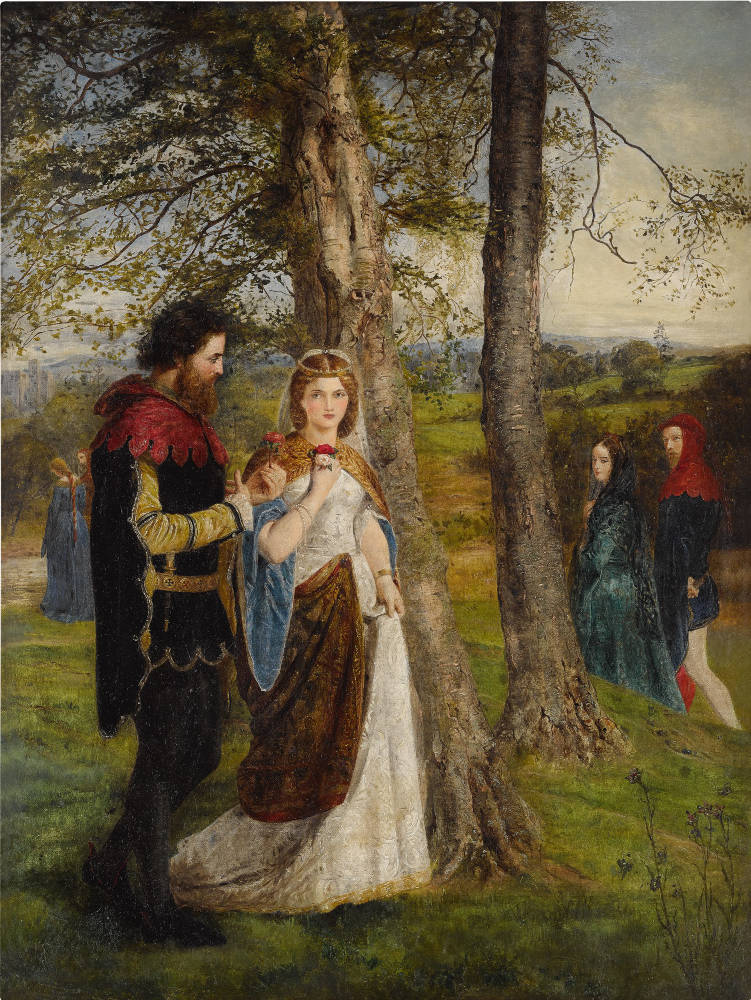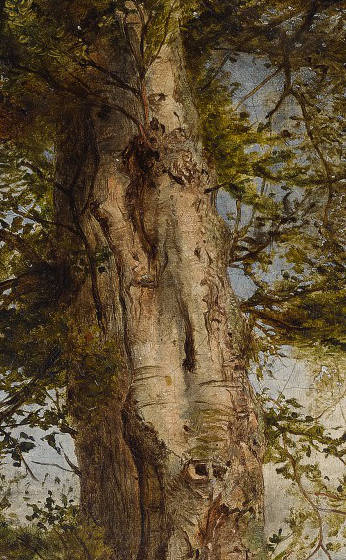

Sir Launcelot Looks on Queen Guinevere by James Archer, c.1864. Oil on canvas, 26 x 19 ½ inches (66.1 x 49.6 cm). Private collection. [Click on images to enlarge them.]
Archer was born in Edinburgh and received his art training there, initially at Trustees’ Academy and later at the life school of the Royal Scottish Academy. He was elected an Associate of the Royal Scottish Academy in 1850, and a full academician in 1858, but moved to London in 1862. He is best known for the series of major works based on the legend of King Arthur that he exhibited at the Royal Academy and Royal Scottish Academy between 1861 and 1868, including his Morte d’ Arthur of 1861 now at the Tate Britain. Archer showed Sir Launcelot Looks on Queen Guinevere in 1864 and The Parting of Arthur and Guinevere in 1865 at the Royal Scottish Academy. This particular painting is likely the aforementioned Sir Launcelot Looks on Queen Guinevere that relates to a larger identical composition Sir Launcelot and Queen Guinevere that Archer exhibited later in 1864 at the Royal Academy. This subject is one of his works most influenced by the second wave of Pre-Raphaelitism. When the larger version was shown at the Royal Academy in 1864 a reviewer for The Art Journal, with obvious conservative tastes, commented: “The remaining picture by Mr. Archer, ‘Sir Launcelot and Queen Guinevere’ (428) scarcely realises the expectation we had formed from his previous productions. He has shown himself hitherto severe – no bad indication in an artist who may be still the student – but in the present work he descends to styles more decorative, and thereby forsakes the higher sphere for which he had entered as no unworthy probationer” (164).



When Archer had exhibited Sir Launcelot Looks on Queen Guinevere earlier that same year at the Royal Scottish Academy a more sympathetic critic for The Art Journal remarked in his review that “James Archer, R.S.A., charms with his rich harmonious colouring in the only historical picture he exhibits, ‘Sir Launcelot looks on Queen Guinevere,’ which has all the fine finish of an old Flemish painting” (120). The description would appear to fit this painting. In the picture Launcelot hands Guinevere a red rose symbolic of passion, true love, and desire. Guinevere also holds a white rose that is the symbol of innocence and purity, perhaps to symbolize that their adulterous relationship had not yet started. She wears a white dress and a head covering reminiscent of that which might be worn by a bride. The trees are treated in a detailed, almost early Pre-Raphaelite manner, while the handling of the background and the foreground might reflect the reviewer’s comment about “the fine finish of an old Flemish painting.” The fabrics are handled with almost the skill of leading Flemish Renaissance painters.
Archer was certainly not alone amongst Victorian artists in painting pictures based on Arthurian themes in the 1850s and 1860s, inspired both by Thomas Malory’s ”Le Morte d’Arthur and by Alfred Tennyson’s ”The Idylls of the King. William Dyce had painted frescoes on these themes for the Palace of Westminster in the 1850s. Dante Gabriel Rossetti and his followers painted Arthurian subjects for the Oxford Union Debating Hall in 1857 during the “Jovial Campaign” and continued to paint such subjects well past that time. Arthurian subjects, in fact, were to occupy artists within the Neo-Pre-Raphaelite movement well into the early 20th century.
Bibliography
The Art Journal. “Exhibition of the Royal Scottish Academy.” New Series III (1864): 118-20.
The Art Journal. “The Royal Academy.” New Series III (1864): 157-168.
The Illustrated London News: “Exhibition of the Royal Academy (Second Notice),” XLIV (May 14, 1864): 479.
Poulson, Christine. The Quest for the Grail: Arthurian Legend in British Art 1840-1920, Manchester: Manchester University Press, 1999, 57-58.
Last modified 29 August 2021